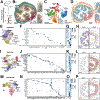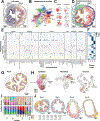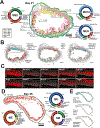Charting the cellular biogeography in colitis reveals fibroblast trajectories and coordinated spatial remodeling
- PMID: 38569542
- PMCID: PMC11017707
- DOI: 10.1016/j.cell.2024.03.013
Charting the cellular biogeography in colitis reveals fibroblast trajectories and coordinated spatial remodeling
Abstract
Gut inflammation involves contributions from immune and non-immune cells, whose interactions are shaped by the spatial organization of the healthy gut and its remodeling during inflammation. The crosstalk between fibroblasts and immune cells is an important axis in this process, but our understanding has been challenged by incomplete cell-type definition and biogeography. To address this challenge, we used multiplexed error-robust fluorescence in situ hybridization (MERFISH) to profile the expression of 940 genes in 1.35 million cells imaged across the onset and recovery from a mouse colitis model. We identified diverse cell populations, charted their spatial organization, and revealed their polarization or recruitment in inflammation. We found a staged progression of inflammation-associated tissue neighborhoods defined, in part, by multiple inflammation-associated fibroblasts, with unique expression profiles, spatial localization, cell-cell interactions, and healthy fibroblast origins. Similar signatures in ulcerative colitis suggest conserved human processes. Broadly, we provide a framework for understanding inflammation-induced remodeling in the gut and other tissues.
Copyright © 2024 Elsevier Inc. All rights reserved.
Conflict of interest statement
Declaration of interests J.R.M. is a co-founder of, stakeholder in, and advisor for Vizgen, Inc. J.R.M. is an inventor on patents associated with MERFISH applied for on his behalf by Harvard University and Boston Children’s Hospital. J.R.M.’s interests were reviewed and are managed by Boston Children’s Hospital in accordance with their conflict-of-interest policies. R.N. is a paid consultant for Quris-AI. V.K.K. has an ownership interest in Tizona Therapeutics, Trishula Therapeutics, Celsius Therapeutics, Bicara Therapeutics, Larkspur Therapeutics. V.K.K. has financial interests in Biocon Biologic, Compass, Elpiscience Biopharmaceutical Ltd, Equilium Inc, PerkinElmer, and Syngene Intl. V.K.K. is a member of SABs for Cell Signaling Technology, Elpiscience Biopharmaceutical Ltd, GlaxoSmithKline, Larkspur, Novartis Sabatolimab, Tizona Therapeutics, Tr1X, and Werewolf. A.C.A. is a member of the SAB for Tizona Therapeutics, Trishula Therapeutics, Compass Therapeutics, Zumutor Biologics, ImmuneOncia, and Nekonal Sarl. A.C.A. is also a paid consultant for iTeos Therapeutics, Larkspur Biosciences, and Excepgen. R.N., V.K.K., and A.C.A.’s interests were reviewed and managed by Mass General Brigham in accordance with their conflict-of-interest policies.
Figures







Update of
-
Charting the cellular biogeography in colitis reveals fibroblast trajectories and coordinated spatial remodeling.bioRxiv [Preprint]. 2023 May 9:2023.05.08.539701. doi: 10.1101/2023.05.08.539701. bioRxiv. 2023. Update in: Cell. 2024 Apr 11;187(8):2010-2028.e30. doi: 10.1016/j.cell.2024.03.013. PMID: 37214800 Free PMC article. Updated. Preprint.
References
-
- Mowat AM, and Agace WW (2014). Regional specialization within the intestinal immune system. Nat. Rev. Immunol 14, 667–685. - PubMed
-
- Beumer J, and Clevers H (2021). Cell fate specification and differentiation in the adult mammalian intestine. Nat. Rev. Mol. Cell Biol 22, 39–53. - PubMed
-
- Nowarski R, Jackson R, and Flavell RA (2017). The stromal intervention: Regulation of immunity and inflammation at the epithelial-mesenchymal barrier. Cell 168, 362–375. - PubMed
-
- Friedrich M, Pohin M, and Powrie F (2019). Cytokine networks in the pathophysiology of inflammatory bowel disease. Immunity 50, 992–1006. - PubMed
MeSH terms
Grants and funding
LinkOut - more resources
Full Text Sources
Other Literature Sources
Medical
Molecular Biology Databases

